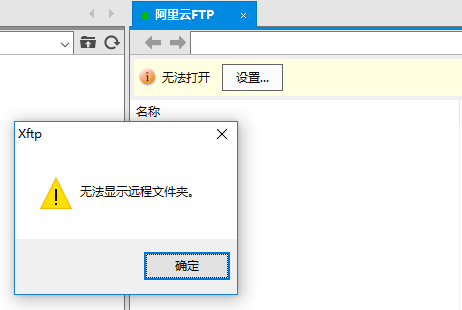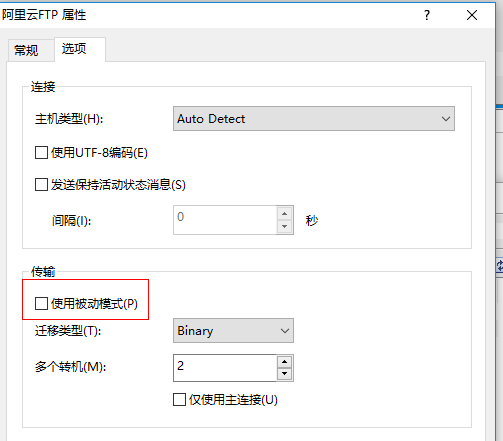第一步,安装vsftpd这款ftp服务器软件,yum install -y vsftpd
第二步,设置vsftpd服务开机自启动,然后重启服务,查看ftp服务端口,centos6命令如下:
#chkconfig vsftpd on
#service vsftpd restart
#netstat -antup|grep ftp
centos7命令如图
安装完成后重启vsftpd服务,service vsftpd restart
第三步:进入vsftpd主配置文件 vi /etc/vsftpd/vsftpd.conf,修改anonymous_enable = NO,这样可以禁止匿名登陆用户登录。
同时,去掉chroot_local_user = yes前的注释,限制用户访问家目录之外的地方
第四步,创建ftp用户,设置用户无法登陆服务器系统并且家目录在/var/www/html下:
给其他人修改文件夹的权限:chmod o+w /var/www/html/
最后关掉selinux,vi /etc/selinux/config
重启系统!或者临时修改selinux,利用setenforce 0,之后再重启vsftpd服务,selinux服务如果没有关掉的话会出现各种问题,比如能访问服务器但是无法打开目录和文件等等。。。
在系统内部尝试自己访问, ftp ip地址,应该能成功登陆,继续配置外网访问
第五步:关闭防火墙,systemctl stop firewalld.service
在浏览器地址中输入 ftp://服务器ip地址,即可访问
###############重点在这里
一、vsftpd 530 Login incorrect 根本原因和解决方案
1 背景分析
ubuntu安装vsftpd一般使用:
sudo apt-get install vsftpd
参照其他网上教程的配置后,在账号、密码、主目录都是正确的情况下,可能会遇到账号登录提示 530 Login incorrect 的问题。
网络上有好多解决方案,例如修改/etc/vsftpd.conf文件 将pam_service_name=vsftpd 修改为 pam_service_name=ftp ,虽然能够解决这个问题,但是这种方法其实是错误的。这样由于/etc/pam.d/ftp文件不存在,等于是绕过了PAM。
2 vsftpd pam文件分析
/etc/pam.d/vsftpd 默认如下
# Standard behaviour for ftpd(8).
auth required pam_listfile.so item=user sense=deny file=/etc/ftpusers
onerr=succeed
# Note: vsftpd handles anonymous logins on its own. Do not enable pam_ftp.so.
# Standard pam includes
@include common-account
@include common-session
@include common-auth
auth required pam_shells.so
可能导致530错误的有
auth required pam_listfile.so item=user sense=deny file=/etc/ftpusers onerr=succeed
和
auth required pam_shells.so
2.1 /etc/ftpusers
auth required pam_listfile.so item=user sense=deny file=/etc/ftpusers onerr=succeed
该配置项的含义是 /etc/ftpusers 中的用户禁止登陆,如果文件不存在在默认所有用户均允许登录. 所以确保用户没在这个文件内。
2.2 pam_shells.so
auth required pam_shells.so 配置项的含义为仅允许用户的shell为 /etc/shells
文件内的shell命令时,才能够成功
cat /etc/shells
# /etc/shells: valid login shells
/bin/sh
/bin/dash
/bin/bash
/bin/rbash
而创建ftp用户时,为了禁止ssh登录,一般多为/bin/false 、/usr/sbin/nologin 等,显然不是一个有效的bash,也就无法登录了。
3 解决方案
1、查看/etc/ftpusers ,确保账号没有在这个文件内。
2、修改/etc/pam.d/vsftpd
将auth required pam_shells.so修改为->auth required pam_nologin.so 即可
3、重启vsftpd
二、设置好ftp后用xftp连接提示无法打开,无法显示远程文件夹
在我设置好ftp后使用xftp软件连接时可以连上但是提示如下,无法显示远程文件夹,最终找到了原因
1. 问题原因
由于ftp连接模式port模式和pasv模式。设置ftp 链接模式为port (主动模式) ,ftp客户端一般默认使用的pasv (被动模式) 。如果不修改模式,用户链接服务器后,目录一直不能显示。所以要修改为主动模式。
2. 解决方案
其实很简单,只需将ftp连接模式改为主动模式。xftp修改方式如下
点击属性->选项->将使用被动模式选项去掉即可
三、centos下ftp服务器搭建(以及启动失败/XFTP客户端一直提示“用户身份验证失败”解决方法)
注:个人对偏向于底层基本上拿来就用的应用,倾向于使用安装包,直接yum或者rpm安装;而对于应用层面控制较多或者需要大范围维护的,倾向于直接使用tar.gz版本。
对于linux下的ftp服务器,实际上有很多的实现,只不过较广泛的在使用的是vsftpd,它是UNIX下一个GPL FTP服务器,全称very secure FTP daemon,官网https://security.appspot.com/vsftpd.html。
1、安装vsftpd,yum install vsftpd
安装完成后,可以执行which vsftpd检查是否安装成功,同时会在/etc/vsftpd下创建三个配置文件,如下:
[root@elk1 vsftpd]# ll
总用量 20
-rw-------. 1 root root 125 8月 3 2017 ftpusers # 指定哪些用户不能访问FTP服务器,这里的用户包括root在内的一些重要用户。
-rw-------. 1 root root 361 8月 3 2017 user_list # 指定的用户是否可以访问ftp服务器,通过vsftpd.conf文件中的userlist_deny的配置来决定配置中的用户是否可以访问,userlist_enable=YES ,userlist_deny=YES ,userlist_file=/etc/vsftpd/user_list 这三个配置允许文件中的用户访问FTP。
-rw-------. 1 root root 5135 6月 8 11:32 vsftpd.conf # 主配置文件
注:vsftpd虽然共享linux的用户,但是做了更加精细化二次安全防护,避免常见的脆弱性安全问题,所以如果希望让root用户访问,需要在ftpusers中注释掉root。
2、安装完成后,默认情况下,直接service vsftpd start就可以启动ftp服务,这就是最傻瓜的方式,全部是使用默认设置,但是在实际中,我们一般需要对配置进行修改满足我们的特定管理要求。比如:
指定根目录,而非默认的/pub。
指定是否启用匿名访问,允许哪些用户访问哪些目录。
设置用户是否可以创建目录,如果不存在的话。
一般来说,对于公有的ftp服务器,需要隔离不同用户的访问权限,一个公司/BU内部的话,一般一个用户,根据目录进行划分就足够,在管理和便利之间权衡。
这里,我们假设ftp目录为/usr/local/app/yidoo/ebs-k3c,同时在其下创建一个file目录,允许ftpadmin/123456用户读写file下的所有文件,但是不允许创建新的目录。匿名用户可以读file下的文件,但是不能写。
首先创建一个专用于ftp的用户ftpadmin。
[root@elk1 vsftpd]# useradd ftpadmin -s /sbin/nologin
[root@elk1 vsftpd]# passwd ftpadmin
更改用户 ftpadmin 的密码 。
新的 密码:
无效的密码: 密码少于 8 个字符
重新输入新的 密码:
passwd:所有的身份验证令牌已经成功更新。
[root@elk1 vsftpd]#
此时,就可以使用ftpadmin访问ftp服务器了,如下:
2. vsftpd的根目录是通过两个参数控制,local_root控制非匿名用户登录时vsftpd进入的目录,anon_root则是匿名用户登录时vsftpd进入的目录,这两个参数都没有默认值,不过笔者测下来是/pub。所以,如果要更改ftp目录的话,设置这两个参数即可。
vim /etc/vsftpd/vsftpd.conf
local_root=/usr/local/app/yidoo/ebs-k3c
anon_root=/usr/local/app/yidoo/ebs-k3c
3. 设置匿名用户可读/不可写,登录用户可写、不可创建目录、不可访问指定的ftp目录外的其他目录。默认情况下,ftp用户登录之后,可以cd到其他目录,比如我们上面创建的ftpadmin可以切换到/etc目录。
anonymous_enable=true #启用匿名用户登录,默认启用
anon_world_readable_only=true #允许匿名用户下载,默认启用
local_enable=true,默认false,这个默认值感觉不合适
write_enable=true
# 下面三个配置主要用于控制细粒度的访问权限
chroot_list_enable=NO #设置是否启用chroot_list_file配置项指定的用户列表文件。默认值为NO。 YES为启用 NO禁用,默认禁用
chroot_local_user=YES #是否将所有用户限制在主目录下,也就是切换到和主目录平级的其他目录或者干脆不相关目录,如上文说的切换到/etc目录,YES为启用 NO禁用.(该项默认值是NO,即在安装vsftpd后不做配置的话,ftp用户是可以向上切换到根目录之外的)
chroot_list_file=/etc/vsftpd/chroot_list #设置是否限制在主目录下的用户名单,至于是限制名单还是排除名单,这取决于chroot_local_user的值,我们可以这样记忆: chroot_local_user总是一个全局性的设定,其为YES时,全部用户被锁定于主目录,其为NO时,全部用户不被锁定于主目录。那么我们势必需要在全局设定下能做出一些“微调”,即,我们总是需要一种“例外机制",所以当chroot_list_enable=YES时,表示我们“需要例外”。而”例外“的含义总是有一个上下文的,即,当”全部用户被锁定于主目录“时(即chroot_local_user=YES),"例外"就是:不被锁定的用户是哪些;当"全部用户不被锁定于主目录"时(即chroot_local_user=NO),"例外"“就是:要被锁定的用户是哪些。这样解释和记忆两者之间的关系就很清晰了!
4.上述配置修改后,重启vsftpd,service vsftpd restart
再次明确访问上述目录的时候,就会提示无法显示远程文件夹,即ftp客户端是不会知道当前根目录对应的实际物理目录的。
5.如果启用了selinux,则需要禁用,并执行如下,否则在文件上传的时候会提示vsftp 553 Could not create file。
[root@elk1 vsftpd]# vim /etc/selinux/config
[root@elk1 vsftpd]# cat /etc/selinux/config
# This file controls the state of SELinux on the system.
# SELINUX= can take one of these three values:
# enforcing - SELinux security policy is enforced.
# permissive - SELinux prints warnings instead of enforcing.
# disabled - No SELinux policy is loaded.
SELINUX=disabled # 这儿
# SELINUXTYPE= can take one of three two values:
# targeted - Targeted processes are protected,
# minimum - Modification of targeted policy. Only selected processes are protected.
# mls - Multi Level Security protection.
SELINUXTYPE=targeted
[root@elk1 vsftpd]# getsebool -a | grep ftp
ftpd_anon_write --> off
ftpd_connect_all_unreserved --> off
ftpd_connect_db --> off
ftpd_full_access --> off
ftpd_use_cifs --> off
ftpd_use_fusefs --> off
ftpd_use_nfs --> off
ftpd_use_passive_mode --> off
httpd_can_connect_ftp --> off
httpd_enable_ftp_server --> off
tftp_anon_write --> off
tftp_home_dir --> off
[root@elk1 vsftpd]# setsebool allow_ftpd_full_access on # 这儿
[root@elk1 vsftpd]# getsebool -a | grep ftp
ftpd_anon_write --> off
ftpd_connect_all_unreserved --> off
ftpd_connect_db --> off
ftpd_full_access --> on
ftpd_use_cifs --> off
ftpd_use_fusefs --> off
ftpd_use_nfs --> off
ftpd_use_passive_mode --> off
httpd_can_connect_ftp --> off
httpd_enable_ftp_server --> off
tftp_anon_write --> off
tftp_home_dir --> off
参考:
vsftpd.conf各配置项官方文档参考https://security.appspot.com/vsftpd/vsftpd_conf.html(注,可能需要FQ才能访问)
配置修改后,启动时遇到Job for vsftpd.service failed because the control process exited with error code. See "systemctl status vsftpd.service" and "journalctl -xe" for details. http://bbs.51cto.com/thread-1480655-1-1.html 19楼终极解决方法,重装,于是把配置全部改回默认值,一个个修改看问题出在哪里。
VSFTPD一直提示“用户身份验证失败”:搭建好之后,当日都正常,自从第二天服务器被重启之后,无论是xftp还是java客户端登录就一直提示“用户身份验证失败”,无论是匿名还是使用root账户或者ftpadmin账户均如此,搜了下网上不少帖子,比如https://yq.aliyun.com/wenzhang/show_11618(但是它仅仅指的是java客户端访问),https://bbs.aliyun.com/read/252932.html?pos=6(它讲的是通过ssh登录,并非ftp),均未看到解决。使用命令行下ftp客户端登录,如下:
用户(192.168.230.128:(none)): ftpadmin
331 Please specify the password.
密码:
500 OOPS: vsftpd: refusing to run with writable root inside chroot()
远程主机关闭连接。
完整配置如下:
[root@elk1 vsftpd]# cat vsftpd.conf
# Example config file /etc/vsftpd/vsftpd.conf
#
# The default compiled in settings are fairly paranoid. This sample file
# loosens things up a bit, to make the ftp daemon more usable.
# Please see vsftpd.conf.5 for all compiled in defaults.
#
# READ THIS: This example file is NOT an exhaustive list of vsftpd options.
# Please read the vsftpd.conf.5 manual page to get a full idea of vsftpd's
# capabilities.
#
# Allow anonymous FTP? (Beware - allowed by default if you comment this out).
anonymous_enable=YES
#
# Uncomment this to allow local users to log in.
# When SELinux is enforcing check for SE bool ftp_home_dir
local_enable=YES
#
# Uncomment this to enable any form of FTP write command.
write_enable=YES
#
# Default umask for local users is 077. You may wish to change this to 022,
# if your users expect that (022 is used by most other ftpd's)
local_umask=022
#
# Uncomment this to allow the anonymous FTP user to upload files. This only
# has an effect if the above global write enable is activated. Also, you will
# obviously need to create a directory writable by the FTP user.
# When SELinux is enforcing check for SE bool allow_ftpd_anon_write, allow_ftpd_full_access
anon_upload_enable=YES
#
# Uncomment this if you want the anonymous FTP user to be able to create
# new directories.
anon_mkdir_write_enable=YES
#
# Activate directory messages - messages given to remote users when they
# go into a certain directory.
dirmessage_enable=YES
#
# Activate logging of uploads/downloads.
xferlog_enable=YES
#
# Make sure PORT transfer connections originate from port 20 (ftp-data).
connect_from_port_20=YES
#
# If you want, you can arrange for uploaded anonymous files to be owned by
# a different user. Note! Using "root" for uploaded files is not
# recommended!
#chown_uploads=YES
#chown_username=whoever
#
# You may override where the log file goes if you like. The default is shown
# below.
#xferlog_file=/var/log/xferlog
#
# If you want, you can have your log file in standard ftpd xferlog format.
# Note that the default log file location is /var/log/xferlog in this case.
xferlog_std_format=YES
#
# You may change the default value for timing out an idle session.
#idle_session_timeout=600
#
# You may change the default value for timing out a data connection.
#data_connection_timeout=120
#
# It is recommended that you define on your system a unique user which the
# ftp server can use as a totally isolated and unprivileged user.
#nopriv_user=ftpsecure
#
# Enable this and the server will recognise asynchronous ABOR requests. Not
# recommended for security (the code is non-trivial). Not enabling it,
# however, may confuse older FTP clients.
#async_abor_enable=YES
#
# By default the server will pretend to allow ASCII mode but in fact ignore
# the request. Turn on the below options to have the server actually do ASCII
# mangling on files when in ASCII mode.
# Beware that on some FTP servers, ASCII support allows a denial of service
# attack (DoS) via the command "SIZE /big/file" in ASCII mode. vsftpd
# predicted this attack and has always been safe, reporting the size of the
# raw file.
# ASCII mangling is a horrible feature of the protocol.
#ascii_upload_enable=YES
#ascii_download_enable=YES
#
# You may fully customise the login banner string:
#ftpd_banner=Welcome to blah FTP service.
#
# You may specify a file of disallowed anonymous e-mail addresses. Apparently
# useful for combatting certain DoS attacks.
#deny_email_enable=YES
# (default follows)
#banned_email_file=/etc/vsftpd/banned_emails
#
# You may specify an explicit list of local users to chroot() to their home
# directory. If chroot_local_user is YES, then this list becomes a list of
# users to NOT chroot().
# (Warning! chroot'ing can be very dangerous. If using chroot, make sure that
# the user does not have write access to the top level directory within the
# chroot)
#chroot_local_user=YES
#chroot_list_enable=YES
# (default follows)
# chroot_list_file=/etc/vsftpd/chroot_list
#
# You may activate the "-R" option to the builtin ls. This is disabled by
# default to avoid remote users being able to cause excessive I/O on large
# sites. However, some broken FTP clients such as "ncftp" and "mirror" assume
# the presence of the "-R" option, so there is a strong case for enabling it.
#ls_recurse_enable=YES
#
# When "listen" directive is enabled, vsftpd runs in standalone mode and
# listens on IPv4 sockets. This directive cannot be used in conjunction
# with the listen_ipv6 directive.
listen=NO
#
# This directive enables listening on IPv6 sockets. By default, listening
# on the IPv6 "any" address (::) will accept connections from both IPv6
# and IPv4 clients. It is not necessary to listen on *both* IPv4 and IPv6
# sockets. If you want that (perhaps because you want to listen on specific
# addresses) then you must run two copies of vsftpd with two configuration
# files.
# Make sure, that one of the listen options is commented !!
listen_ipv6=YES
pam_service_name=vsftpd
userlist_enable=YES
tcp_wrappers=YES
local_root=/usr/local/app/yidoo/ebs-k3c
chroot_local_user=YES
# chroot_list_enable=false
anon_root=/usr/local/app/yidoo/ebs-k3c
当我注释掉chroot_local_user的时候,也就是不限制用户切换到主目录之外就不出错了。找到具体的错误信息解决问题就很简单了,经查:
这个问题发生在最新的这是由于下面的更新造成的:
- Add stronger checks for the configuration error of running with a writeable root directory inside a chroot(). This may bite people who carelessly turned on chroot_local_user but such is life.
从2.3.5之后,vsftpd增强了安全检查,如果用户被限定在了其主目录下,则该用户的主目录不能再具有写权限了!如果检查发现还有写权限,就会报该错误。
要修复这个错误,可以用命令chmod a-w /home/user去除用户主目录的写权限,注意把目录替换成你自己的。或者你可以在vsftpd的配置文件中增加下列两项中的一项:
allow_writeable_chroot=YES
在配置文件中加上上面的配置项之后,无论是xftp还是原生ftp客户端,均可以正常访问了。
最后
以上就是迷人冬日最近收集整理的关于centos7下配置ftp服务器,各种登录异常排查二、设置好ftp后用xftp连接提示无法打开,无法显示远程文件夹1. 问题原因2. 解决方案三、centos下ftp服务器搭建(以及启动失败/XFTP客户端一直提示“用户身份验证失败”解决方法) 注:个人对偏向于底层基本上拿来就用的应用,倾向于使用安装包,直接yum或者rpm安装;而对于应用层面控制较多或者需要大范围维护的,倾向于直接使用tar.gz版本。的全部内容,更多相关centos7下配置ftp服务器,各种登录异常排查二、设置好ftp后用xftp连接提示无法打开,无法显示远程文件夹1.内容请搜索靠谱客的其他文章。




















发表评论 取消回复